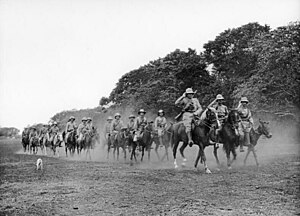Battle of Kilimanjaro
| Battle of Kilimanjaro | |||||||
|---|---|---|---|---|---|---|---|
| Part of the East African Campaign of World War I | |||||||
 A mounted contingent of the German colonial volunteer 8th Rifle Company, 1914 |
|||||||
|
|||||||
| Belligerents | |||||||
|
|
|
||||||
| Commanders and leaders | |||||||
| Major Georg Kraut | Brigadier J. M. Stewart | ||||||
| Strength | |||||||
| 686 | ~1,500 | ||||||
| Casualties and losses | |||||||
| 109 | 312 | ||||||
The Battle of Kilimanjaro at Longido took place in German East Africa in November 1914 and was an early skirmish during the East African Campaign of the First World War.
The British conquest of German East Africa was planned as a two-pronged invasion of the German colony, at the port town of Tanga and the settlement Longido on the slopes of Mount Kilimanjaro. The plan was designed at a Mombasa staff conference with Major General Arthur Aitken in overall command. The first and largest prong was an advance towards Tanga by the British Indian Expeditionary Force "B", consisting of some 8,000 men organised into two brigades.
The second prong would be an attack on the German defences at Longido in the north around Kilimanjaro, then swing south and seize Neu Moshi, the western terminus of the Usambara or Northern Railroad. According to author Charles Miller, "the objective for the capture of Longido was to squeeze the German Schutztruppe in the upper end of a two-hundred-mile pincer." The region was a major German settlement area with established plantations of sisal, coffee and other cash crops at the northern edge of the Usambara highlands. Since small German raiding parties had already begun to ambush British detachments and attack the Uganda Railway, the destruction of German forces in the area bordering British East Africa was a key objective of the British plan of operation. Miller later wrote that "the strategy was faultless on paper."
By late October 1914 the British Indian Expeditionary Force "C" gathered with 4,000 men near the border of British and German East Africa, commanded by Brigadier General J. M. Stewart. The brigade included colonial volunteers who called themselves the East Africa Mounted Rifles. Flawed intelligence reports estimated the German military presence in the region at 200 men; however, there were 600 askaris in three companies plus the colonial volunteers of 8th Schützenkompagnie [rifle company] of 86 young Germans on horseback.
...
Wikipedia
